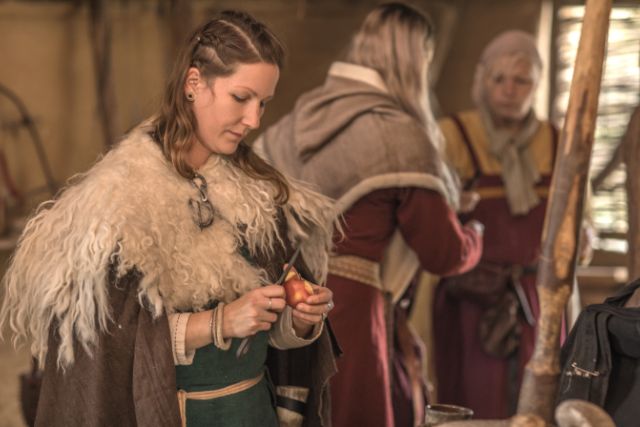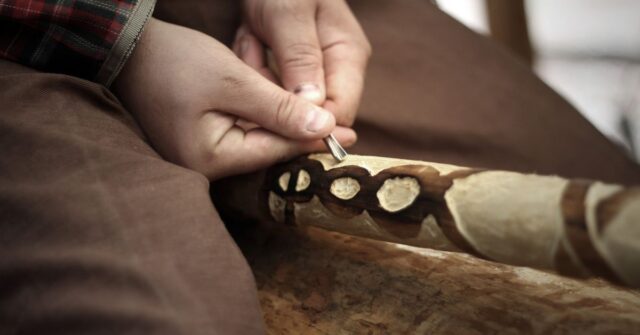Imagine the Viking world, often stereotyped with its fierce warriors and imposing longships. Yet, beneath this rugged exterior lies a rich tapestry of culture, quite literally.
Viking textiles, though less sung, paint a vivid picture of their daily lives, artistry, and social structures. Let’s unravel the threads of history and weave through the fascinating world of Viking textiles.
Introduction
The mention of Vikings might conjure images of battles and explorations, but their textile production reveals a different side of their world.
A side where artistry and practicality intertwine, showcasing a society that valued both function and beauty.
The Significance of Textiles in Viking Society
In Viking society, textiles were more than mere clothing; they were indicators of status, wealth, and skill.
A finely woven cloak or a brightly colored tunic could say much about a person’s position and expertise in society. This was a world where your cloak could quite literally make or break your reputation.

Overview of Viking Age and Textile Production
The Viking Age, spanning from the late 8th to the early 11th century, was a time of significant cultural development and exchange, aspects vividly reflected in their textiles.
Using materials readily available in their environment, Vikings created textiles that were both practical for their harsh climates and expressive of their cultural identity.
Materials Used in Viking Textiles
Vikings were resourceful people who utilized every available resource, and their textile materials were no exception.
From the wool of their sheep to the flax grown in their fields, they knew how to make the most of what they had.
Wool: The Backbone of Viking Textiles
Wool was the workhorse of Viking textiles. Its versatility and availability made it the most common material for clothing and sails.
Imagine the skill it took to transform the coarse wool into a garment that could keep out the chill of a Scandinavian winter.
Linen: The Prestige Material
Linen, derived from the flax plant, held a prestigious place in Viking society. It was often used for finer garments and underclothes, appreciated for its smoothness and cooler feel in the summers.
Other Materials: Silk, Hemp, and Nettle
Vikings were not above trading for luxury, and silk fragments found in burials attest to their trade connections.
Hemp and nettle were the unsung heroes, providing sturdy materials for everyday wear and utilitarian needs.

Textile Production Techniques
The creation of textiles in the Viking Age was an art form, passed down through generations. From the spinning of yarn to the weaving of intricate patterns, each step required skill and patience.
Spinning and Weaving: The Basics of Textile Creation
The rhythmic hum of the spindle and the loom were common sounds in a Viking household. Spinning transformed raw wool and flax into yarn, while weaving turned that yarn into fabric.
This process was not just about making clothing; it was about creating art.
Dyeing Techniques: Colors of the Viking World
The Vikings knew their way around a color palette. Using natural dyes from plants, minerals, and even insects, they created vibrant textiles that have faded little over the centuries.
It’s a testament to their dyeing skills that we can still see their love for color today.
Decorative Techniques: Embroidery and Tablet Weaving
Embroidery and tablet weaving added flair to the function.
With needle and thread, Vikings added intricate designs to their garments, while tablet weaving created strong, decorative bands used for everything from trimming clothes to hanging items.
Designs and Patterns in Viking Textiles
The patterns and designs found in Viking textiles offer a glimpse into their world. Geometric shapes, animal motifs, and representations of mythological stories were common, each telling a story of its own.

Geometric Patterns and Their Meanings
Geometric patterns were not just decorative; they were symbolic.
The interlocking designs found in many textiles are thought to represent the interconnectedness of life, a belief deeply rooted in Viking spirituality.
Animal and Mythological Motifs
The animals woven into Viking fabrics were not random choices. Each species, from the serpent to the eagle, held specific meanings and attributes the Vikings admired and wished to embody.
Influence of Trade and Contact on Viking Textile Designs
The Vikings were avid traders, and their textiles reflected the cultural exchanges of their travels.
Eastern motifs and Islamic patterns found in Viking burials highlight the wide-reaching connections of their trade networks.
The Role of Textiles in Viking Society
Textiles in Viking society were a tapestry of function, fashion, and symbolism. They clothed the people, filled their sails, and even served as currency in their trade dealings.
Clothing and Identity
In a world where your clothes were made by hand, each garment was a statement of identity.
The cut of a tunic, the color of a dress, and even the weave of a cloak could tell you about a person’s status, profession, and region.

Textiles in Trade and Economy
Textiles were so valued that they were often used as a form of currency.
A well-made sail or a finely woven garment could be traded for goods or services, a testament to the skill of Viking weavers and the importance of textiles in their economy.
Religious and Ceremonial Uses of Textiles
Textiles held a sacred place in Viking rituals. From the cloths used to wrap sacred objects to the sails of ships buried with their dead, textiles were a bridge between the physical and spiritual worlds.
Archaeological Discoveries and Historical Texts
The remnants of Viking textiles found in burials and settlements offer a tangible connection to the past.
Each fragment tells a story, providing insights into the daily lives and artistic expressions of the Viking people.
Key Findings from Burial Sites and Settlements
The discovery of well-preserved textiles in Viking burials has been a goldmine for historians.
These finds not only showcase the Vikings’ skill as textile makers but also offer clues about their beliefs, trades, and connections with the wider world.
Written Sources on Viking Textiles
While archaeological finds give us a direct link to the past, written sources from the era provide context.
Sagas, poems, and historical texts mention textiles, offering insights into their significance in Viking culture.
Preservation and Study of Viking Textiles
Preserving ancient textiles is a delicate task.
Over the years, researchers have developed innovative techniques to conserve these fragile links to our past, ensuring they continue to tell their stories for generations to come.

Challenges in Preserving Ancient Textiles
The biggest challenge in textile preservation is the delicate nature of the materials.
Techniques like controlled environments and careful cleaning are used to prevent degradation, a meticulous process that requires both patience and expertise.
Modern Techniques in Textile Archaeology
Today, technology plays a key role in the study of ancient textiles.
From 3D scanning to microscopic analysis, these modern tools allow researchers to uncover the secrets of Viking textiles without damaging the original pieces.
Conclusion
The world of Viking textiles is a vivid illustration of a culture that valued beauty, utility, and expression.
As we piece together the fragments of their textiles, we weave a richer understanding of the Viking world, a world where every thread tells a story.
Further Reading and Resources
For those captivated by the intricate world of Viking textiles, there’s much more to explore. From scholarly articles to museum exhibits, the journey into the past is as enriching as it is enlightening.
Who knows? You might just find yourself picking up a spindle and thread to try your hand at weaving your own Viking tale.











